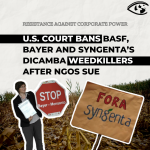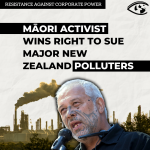USA: Cigarette Companies Target Ethnic Groups to Expand Markets, Activists Complain
Asian community leaders -- mindful of "World No Tobacco Day" on May 31 -- say their battle to reduce high smoking rates among Asian Americans is making inroads but can't succeed as long as cigarette advertisers keep targeting their neighborhoods.
"It's sort of ironic that in May, which is Asian Pacific Heritage Month, our communities are being attacked by the tobacco industry," said Rod Lew, director of Asian Pacific Partners for Empowerment and Leadership (APPEAL), a year-old national anti-tobacco coalition.
"We're also talking about Asia as well. Since 63 percent of our community are immigrants, they're very much impacted by the kind of tobacco tactics taken in their home countries."
However, a billboard flap last February reflects how effective anti-tobacco activists have been in making their communities more smoke-free. A "Maverick Specials" billboard, just above street level on a busy block of San Francisco's Chinatown, got even more attention than advertisers had bargained for.
"We were organizing a protest when they covered it up," said Chinese Progressive Association spokesman Gordon Mar. "We achieved our objective."
Another recent victory was the banishment of cigarette promotions at San Jose's popular Tet Festival this year.
Ironically, national studies report that Asians don't have a significant smoking problem. In 1994, the Asian Pacific Islander adult smoking rate was 13.9 percent, compared with 25.5 percent for the average American adult, according to the Centers for Disease Control in Atlanta.
Whites, African Americans and Hispanics all had higher rates; the highest was 42.2 percent among American Indians and Alaskan natives.
But Asian Pacific health advocates assert national studies tend to survey more acculturated English-speaking Asian Americans, who are much less likely to smoke.
Smaller, local studies show a much different picture, they say.
A 1996 study by UC-San Francisco's Vietnamese Community Health Promotion Project reported the smoking rate among Vietnamese males at 36 percent.
The smoking rate for Korean American males in Alameda County was 38.7 percent in a 1995 study by Asian Health Services in Oakland.
"What gets released on a national level indicates that Asian Pacific Islanders as a whole have no smoking problems," Lew said. "But what we know in our community is that a lot of people smoke, especially young people."
Still, today's Asian smoking rates are much lower than those reported in the 1980s, when many immigrants first arrived. Those estimates ranged from 56 to 72 percent for various Asian ethnic groups -- similar to rates found in Asian countries.
What's aiding health advocates is the gradual acculturation of immigrants. The longer they're here, the less they smoke.
"The social environment here doesn't allow them to smoke as much," said Chris Jenkins of UC-San Francisco's Vietnamese Community Health Promotion Project. "They can't smoke on an airplane. They can't smoke in the workplace. So the pressures start to mount. And they start to quit."
Advocates say that process has been slowed by the concentration of tobacco advertising and promotions in Asian Pacific Islander neighborhoods an assertion documented in several studies.
A 1992 study of four ethnic neighborhoods in San Francisco by California Rural Legal Assistance found that Asian Pacific Islander neighborhoods had a disproportionate number of tobacco billboards, with nearly 30 percent of billboards in those areas advertising cigarettes.
Another study of ethnic neighborhoods in San Diego in 1992 -- reported in the periodical Health Values -- said the average number of tobacco billboards per mile was 17 times higher in Asian communities than in white areas.
Walking the streets of his neighborhood, Anh Le, a coordinator for a tobacco education program of the UCSF project, didn't have to look far for evidence.
"In the Tenderloin, cigarette billboards and posters blight every city block in a neighborhood heavily populated by poor, newly arrived immigrants from Southeast Asia, African Americans and other minorities," said Le. "Cigarette advertisements on large billboards, store windows and city-franchised bus shelters greet young children as they walk home from school."
He pointed out the ubiquitous blue-and-gold "State Express 555" awnings on many storefronts. "555" is a very popular brand marketed here by Brown and Williamson Tobacco Corp. and in Vietnam and other countries by B & W's corporate parent, B.A.T. Industries.
Other promotional tactics from free T-shirts and baseball caps to contests and videos of car races in Asia help when peddling "555" and other brands like Marlboro. Ads in Vietnamese newspapers also advertise cigarettes.
Jenkins' project last year filed a complaint with the Federal Trade Commission over a bilingual "555" newspaper ad that left the surgeon general's warning in English. But no action was taken.
The project also helped oust "555" promoters from San Jose's Tet Festival, where in previous years, T-shirts and other free items had been given away at a "555" booth.
Responding to critics, Brown and Williamson spokesman Tom Fitzgerald said, "Naturally, when adult consumers come to this country, they're interested if their brand is available. Our advertising seeks to meet the demand of Asian American customers who are very capable of making an informed choice about their brand preference."
Walker Merryman, vice president of The Tobacco Institute, a Washington, D.C.-based industry organization, said market concentration is as old as advertising.
"Cigarette companies, as any consumer product company, will advertise where it believes its customers are," Merryman said. "To the extent you're able to do so, you concentrate your marketing there."
Those are fighting words to Jenkins and other advocates, who have countered with a few promotions of their own. Billboards, along with print and broadcast ads, now carry anti-tobacco messages in different languages. The UCSF project has developed an anti-smoking video and conducted a contest to quit smoking.
"All of these have been very effective," Jenkins said.
But even the optimistic advocates say they are hampered by the soaring marketing of cigarettes in Asia.
The Tobacco Institute reports that the United States was the leading exporter of tobacco for 1995, with the value of American exports of tobacco leaf and its products reaching $6.6 billion.
In Vietnam, "Marlboro women," dressed in the brand colors of red and white, give out free smokes at cafes and nightclubs. The brand has even spawned a local copycat brand, "Boy Boy," with its own Vietnamese Marlboro man, complete with a cowboy hat.
Mar and others see that as another challenge to be tackled.
"We're definitely looking at overseas," Mar said. "We've been meeting with other Asian anti-tobacco groups to start developing action. It's definitely related to the problem here in our own community."
- 109 Tobacco



